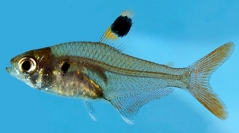

 European Journal of Taxonomy
723 (77) - Pages 77-107
European Journal of Taxonomy
723 (77) - Pages 77-107Two new species, Hyphessobrycon frickei Guimarães, Brito, Bragança, Katz & Ottoni sp. nov. and H. geryi Guimarães, Brito, Bragança, Katz & Ottoni sp. nov., are herein described, based on seven different and independent species delimitation methods, and on molecular and morphological characters, making the hypothesis of these new species supported from an integrative taxonomy perspective. They belong to the “Rosy tetra” clade, which is mainly characterized by the presence of a dark brown or black blotch on the dorsal fin and the absence of a midlateral stripe on the body. These two new species are distinguished from the other members of this clade mainly by the arrangement, shape and color pattern of humeral and dorsal-fin spots, as well as by other characters related to scale counts and body pigmentation. The placement of the new species within the “Rosy tetra” clade was based on the combination of morphological character states mentioned above and corroborated by a molecular phylogenetic analysis using the mitochondrial gene cytochrome oxidase subunit 1. In addition, a new clade (here termed Hyphessobrycon copelandi clade) within the “Rosy tetra” clade is proposed based on molecular data, comprising H. copelandi, H. frickei sp. nov., H. geryi sp. nov. and a still undescribed species. Our results corroborate the occurrence of hidden species within the “Rosy tetra” clade, as suggested by previous studies.